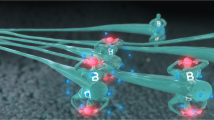Abstract
Purpose. To design glucose-responsive gels based on the complexation between polymers having phenylboronic acid groups and poly (vinyl alcohol). Specifically, high-glucose sensitivity at physiological pH was achieved through the interaction of phenylborate with amino groups.
Method. Terpolymers of m-acrylamidophenylboronic acid, N,N-dimethylaminopropylacrylamide (DMA-PAA), and N,N-dimethylacrylamide were prepared. DMAPAA was introduced in the terpolymer to stabilize phenylborate-polyol complex at physiological pH. The effect of amino groups on complex stabilization was estimated from viscosity as well as UV spectrum measurements.
Results. A good correlation was observed between complexation rate and fraction of phenylborate as well as DMAPAA in the terpolymers. In line with this increased complexation rate. UV difference spectra measurement revealed that ionization of phenylboronic acid was facilitated in the terpolymer due to the interaction with DMAPAA. Further, sensitive change in the complexation rate was demonstrated with a variation in glucose concentration, which is in sharp contrast with the poor glucose-sensitivity of the polymer without DMAPAA.
Conclusions. The introduction of an amino group into phenylborate polymers was quite effective for increasing the complexation ability and the glucose responsivity at physiological pH. These results suggest the feasibility of this complex-gel system in designing a self-regulated insulin-releasing device.
Similar content being viewed by others
REFERENCES
M. Shichiri, N. Asakawa, Y. Yamasaki, R. Kawamori, and H. Abe. Diabetes Care 9:298–301 (1986).
S. Sato, S. Y. Jeong, J. C. McRea, and S. W. Kim. J. Contr. Rel. 1:67–77 (1984)
E. Kokufuta, Y. Q. Zhang and T. Tanaka. Nature 351:302–304 (1991).
S. Kitano, Y. Koyama, K. Kataoka, T. Okano, and Y. Sakurai. Makromol. Chem., Rapid Commun. 12:227–233 (1991).
S. Kitano, Y. Koyama, K. Kataoka, T. Okano, and Y. Sakurai. J. Contr. Rel. 19:161–170 (1992).
D. Shiino, Y. J. Kim, Y. Murata, M. Yamaguchi, K. Kataoka, Y. Koyama, M. Yokoyama, T. Okano, and Y. Sakurai. Chem. Lett. 1993:1799–1802 (1993).
S. Kitano, I. Hisamitsu, Y. Koyama, K. Kataoka, T. Okano, and Y. Sakurai. Polym. Adv. Tech. 2:261–264 (1991).
S. Soundararajan, M. Badawi, C. M. Kohlrust, and J. H. Hageman. Anal. Biochem. 178:125–134 (1989).
S. X. Cai and J. F. W. Keana. Bioconjugate Chem. 2:317–322 (1991).
Author information
Authors and Affiliations
Rights and permissions
About this article
Cite this article
Hisamitsu, I., Kataoka, K., Okano, T. et al. Glucose-Responsive Gel from Phenylborate Polymer and Poly (Vinyl Alcohol): Prompt Response at Physiological pH Through the Interaction of Borate with Amino Group in the Gel. Pharm Res 14, 289–293 (1997). https://doi.org/10.1023/A:1012033718302
Issue Date:
DOI: https://doi.org/10.1023/A:1012033718302




